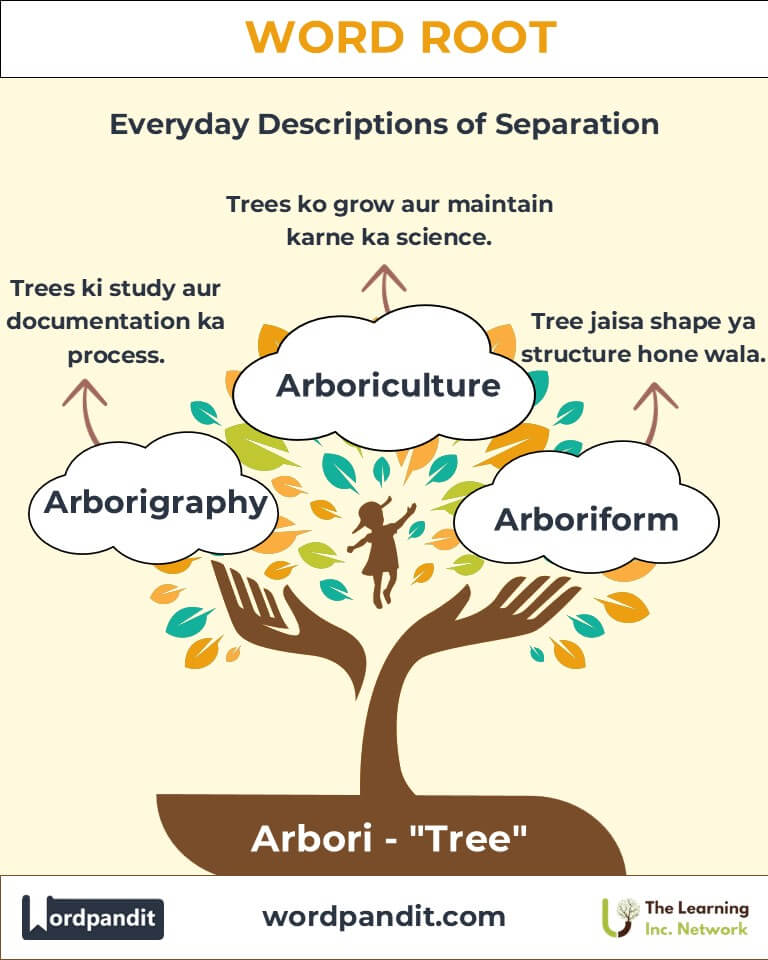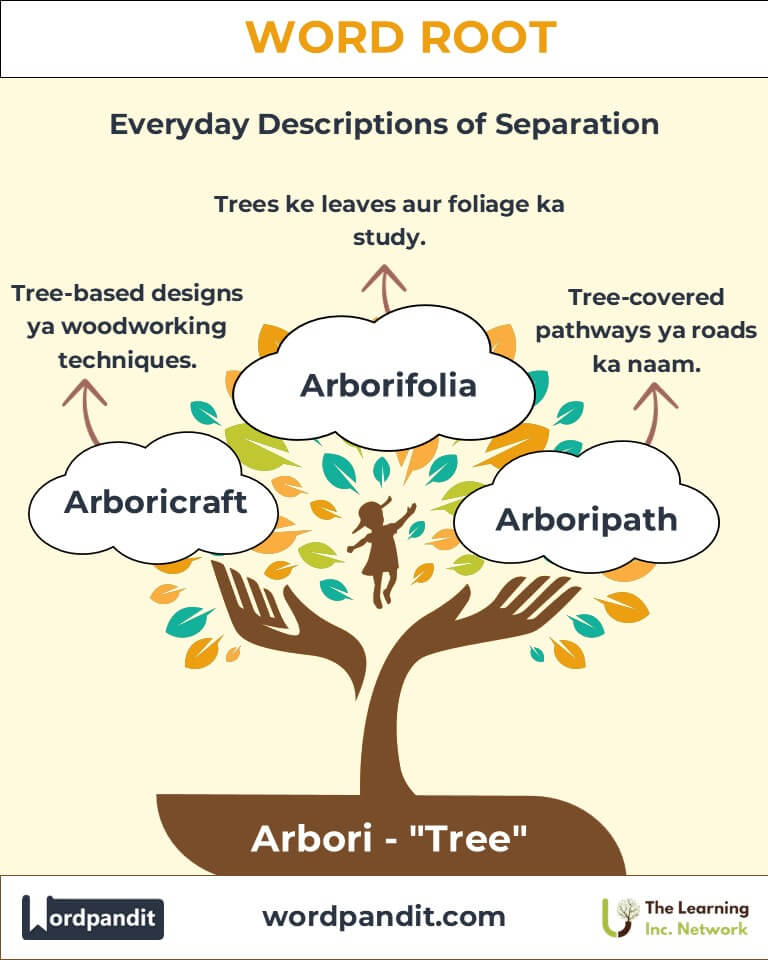Arbori: Rooted in Growth and Vitality Across Disciplines
Explore the beauty and significance of the root "arbori," derived from the Latin word meaning "tree." From the arboreal habitats of wildlife to the arborescent structures of modern design, this root branches into diverse areas of life, science, and culture.

Table of Contents
- Introduction: The Essence of Arbori
- Etymology and Historical Journey
- Mnemonic: Unlocking the Power of Arbori
- Common Arbori-Related Terms
- Arbori Through Time
- Arbori in Specialized Fields
- Illustrative Story: Arbori in Action
- Cultural Significance of Arbori
- The Arbori Family Tree
- FAQs about the Arbori Word Root
- Test Your Knowledge: Arbori Word Root Quiz
- Conclusion: The Living Legacy of Arbori
Introduction: The Essence of Arbori
Imagine a world without trees—the foundation of ecosystems and a symbol of life’s endurance. The word root "arbori" (pronounced ar-boh-ree) captures the vitality and elegance of trees. Originating from Latin, it has sprouted into numerous words and concepts across languages and disciplines. Whether describing the arboreal lifestyle of animals or the arborescent structures in architecture, this root embodies growth, stability, and connection.

Etymology and Historical Journey
The root "arbori" traces back to the Latin word arbor, meaning tree. In classical Rome, trees symbolized strength, shelter, and nature’s beauty. Over time, this root enriched vocabulary in various fields, from poetry and botany to engineering and urban planning. Its evolution reflects humanity's enduring relationship with trees, both literal and metaphorical.
Mnemonic: Unlocking the Power of Arbori
To remember "arbori," visualize a magnificent oak tree branching out under the sun, representing growth and resilience.
Mnemonic Device: "Arbori anchors like a tree—roots in the past, branches in the future."
Common Arbori-Related Terms
- Arboreal (ar-boh-ree-uhl)
- Definition: Relating to or resembling trees, or inhabiting trees.
- Example: "Monkeys, known for their arboreal lifestyle, thrive in dense forests."
- Arborescent (ar-boh-res-ent)
- Definition: Tree-like in appearance or structure.
- Example: "The arborescent patterns of coral reefs mimic the branching of trees."
- Arborist (ar-bor-ist)
- Definition: A specialist in the care and cultivation of trees.
- Example: "The arborist pruned the ancient oak to preserve its health."
- Arboretum (ar-bor-ee-tum)
- Definition: A botanical garden dedicated to the collection and study of trees.
- Example: "The city’s arboretum showcases rare and exotic tree species."
- Arborvitae (ar-bor-vi-tay)
- Definition: A type of evergreen tree whose name means "tree of life."
- Example: "Arborvitae hedges are a popular choice for natural privacy screens."
Arbori Through Time
- Arbor Day (1872): The establishment of Arbor Day in the United States highlighted the importance of planting trees for environmental conservation.
- Arboreal in Evolutionary Studies: The term became pivotal in describing species that adapted to tree-dwelling, offering insights into primate and bird evolution.
Arbori in Specialized Fields
- Ecology:
- Arboreal species play crucial roles in forest ecosystems, maintaining biodiversity.
- Example: The orangutan, an arboreal ape, is a keystone species in rainforests.
- Urban Planning and Design:
- The concept of arborescent structures inspires sustainable architecture, such as tree-like skyscrapers with integrated greenery.
- Medicine and Pharmacology:
- Trees like the arborvitae have medicinal properties, used in herbal remedies and essential oils.
Illustrative Story: Arbori in Action
In a bustling city, Maya, an arborist, noticed a beloved century-old oak struggling to survive amid urban sprawl. With her expertise, she designed an arborescent support system to stabilize its branches while educating the community on preserving green spaces. Her efforts not only saved the tree but inspired an urban arboretum project, connecting people with nature in the heart of the city.
Cultural Significance of Arbori
Trees hold symbolic and cultural significance across civilizations:
- Ancient Myths: Trees like Yggdrasil (Norse mythology) represented the universe's interconnectedness.
- Modern Traditions: Arbor Day and tree-planting ceremonies celebrate environmental stewardship and community.

The Arbori Family Tree
- Dendro- (Greek: tree)
- Dendrology: The study of trees.
- Dendrite: A branching structure, like a neuron’s extensions.
- Silva- (Latin: forest)
- Sylvan: Relating to wooded areas.
- Silviculture: The practice of managing forests.
- Botan- (Greek: plant)
- Botany: The scientific study of plants.

FAQs About " Arbori "
Q: What does "arbori" mean?
A: Arbori originates from the Latin word arbor, meaning "tree." It is the root for words related to trees, their structure, and their symbolic representations, such as in arboreal (living in trees) or arboretum (a collection of trees).
Q: What is an arboreal species?
A: Arboreal species are animals that primarily live in trees. They have adaptations like prehensile tails, strong limbs, or claws that help them navigate their tree-dwelling habitats. Examples include koalas, monkeys, and certain bird species.
Q: How is "arborist" different from "forester"?
A: An arborist is a specialist in the care and maintenance of individual trees, often working in urban or residential areas. A forester, on the other hand, manages entire forest ecosystems, focusing on timber production, conservation, and habitat management.
Q: What does "arborescent" describe?
A: "Arborescent" describes anything that resembles a tree in shape or structure. It is often used in biology (to describe branching corals or plants) and in design (tree-like architectural forms).
Q: Why is Arbor Day important?
A: Arbor Day is a holiday dedicated to planting and caring for trees. It raises awareness about the environmental importance of trees, such as reducing carbon dioxide, improving air quality, and providing habitats for wildlife.
Q: What is the significance of "arborvitae"?
A: Arborvitae, Latin for "tree of life," refers to evergreen trees like Thuja. They are symbolic in some cultures for longevity and have practical uses, including landscaping and medicinal applications (e.g., essential oils).
Q: What is an arboretum, and how is it used?
A: An arboretum is a garden or space dedicated to growing and studying trees and shrubs. These spaces serve scientific, educational, and recreational purposes, helping researchers understand tree species and offering the public a chance to connect with nature.
Q: Are trees culturally significant in ancient traditions?
A: Yes, trees have deep cultural and mythological significance. In Norse mythology, Yggdrasil is a cosmic tree connecting different realms. Similarly, many cultures regard trees as sacred symbols of life, growth, and spiritual connection.
Test Your Knowledge: " Arbori " Mastery Quiz
1. What does "arboreal" mean?
2. What is an "arborist"?
3. Which tree is known as the "tree of life"?
4. What does "arborescent" describe?
5. What is an "arboretum"?
Conclusion: The Living Legacy of Arbori
The root "arbori" symbolizes the enduring beauty and significance of trees in language, culture, and science. From arboreal habitats to urban arboretums, it branches into fields that sustain life and inspire innovation. As we nurture our connection to trees, the legacy of "arbori" reminds us to grow and flourish like the trees themselves.












